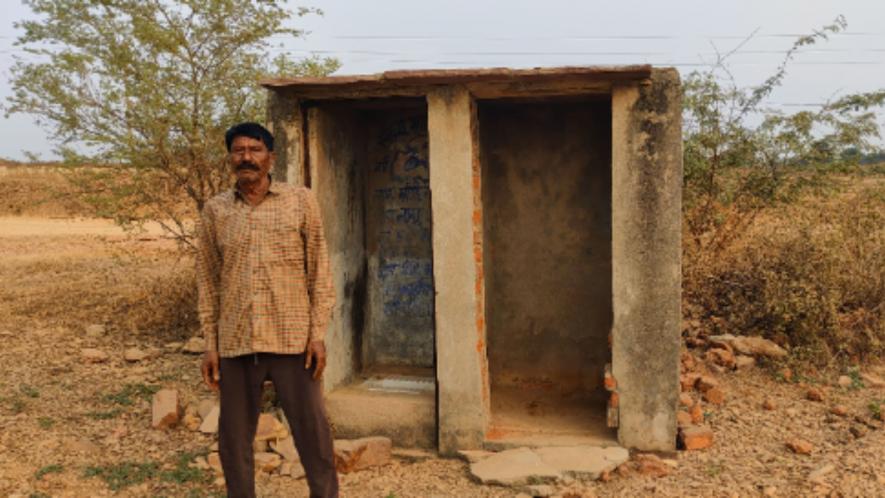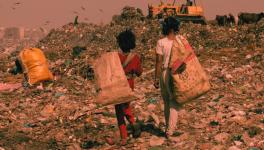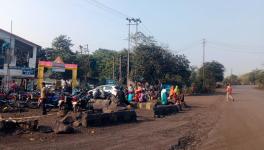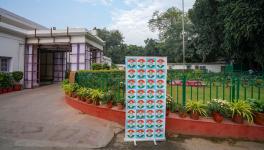MP Elections: Swachh Bharat Mission in Tribals Areas Goes Down Drain

Mangi Lal, a Dalit resident of Mandsaur’s Panch Khaira village, outside the toilet constructed around six years ago. The toilet has no septic tank.
Bhopal: The ruins of toilets in Madhya Pradesh’s (MP) tribal hamlets tell the story of the government’s ambitious Swachh Bharat Mission-Grameen in the last eight years.
These individual household latrines were constructed under the countrywide scheme, launched on October 2, 2014, to eliminate open defecation and attain cleanliness.
However, most toilets in MP’s tribal areas lack doors and septic tanks. The rest are unusable due to the lack of clean water.
The toilets are used to store grains or tendu leaves or shelter animals. Men with plastic bottles or lotas at dawn and women in small groups mostly after dusk or before dawn can be spotted going for defecation.
Shockingly, chief minister Shivraj Singh Chouhan declared in 2018 that the state would be declared open defecation-free (ODF) Plus by October 2 that year. According to official data, more than 72 lakh toilets were constructed in 50,279 villages by 2022, of which 49,994 were declared ODF Plus.
Tribals account for 22% of the state’s population and the condition of toilets in 89 tribal blocks is no different.
The Centre pats its back for building 10.9 crore toilets at the cost of Rs 83,937.72 core in the past eight years. However, a research paper prepared by the World Bank and a faculty of Economics at Yale University over the progress of the scheme showed a massive decline in the use of toilets by Scheduled Castes and Scheduled Tribes after 2018-19.
“While regular use of toilets declined for all groups, the decline is the largest for the Schedule Castes (SCs) and the Scheduled Tribes (STs). There was a 20 percentage point decline in regular use of toilets for SCs and a 24-percentage point decline for STs compared to a decline of 9 and 5 percentage points for the Other Backward Caste and General categories,” the research paper states.
The research put MP among seven states which have seen an uneven decline in toilet use since 2018.
In some tribal hamlets where clean water is accessible, toilets have colourful handmade paintings, but they are reserved only for women and girls while men defecate in the open.
In Jhabua’s Dhekal Badhi village, 10 km from the district headquarters, where clean water is scarce, Pooja Bhuria says that toilets are reserved for the elderly while others defecate in the open. There are two box-sized toilets across the road, but the nearest water source is a kilometre away, forcing them to limit their use only to aged family members.
The village, with more than 100 families, depends on one handpump and a seasonal nala. “We queue before the handpump for hours to fill two buckets of water at a time in the morning,” says Bhuria’s 14-year-old daughter. The villagers use the nala for bathing and washing clothes.
Supour Singh Bhuria, from Dhekal Badhi village, says that the contractor built only a box-sized toilet, installed a door and didn’t bother constructing a septic tank. “We use it only for bathing and defecate in the open.”
The condition of toilets in Dhar’s Sardarpur locality, 50 km from Jhabua, is the same. Corruption and water scarcity have failed the scheme in Sardarpur’s Govindpura village, located on the NH-47.
Kamla Bai, from Govindpura, complained that the contractor only built a box-sized room and installed the toilet seat, but without digging a septic pit. “We tried to dig one, but it started leaking within a month. Therefore, we only use it for bathing,” she says.
Kamla Bai and other residents of Govindpura village, Sardarpur, defecate near a nalla.
The residents of Govindpura also defecate in the open. “We used to defecate on the other side of the highway. But after a woman who was going for defecation died in an accident while crossing the highway, we defecate ear a nala a kilometre away,” she adds carrying two buckets of water.
Two cement water tabs were built outside her house under the Jal Jeevan Mission to provide clean water a year ago, but pipes haven’t been laid.
The condition is similar in hamlets dominated by Dalits, who account for 17% of the state’s population, 5% less than that of tribals.
Almost 200 km from Jhabua, in Mandsaur’s tribal-dominated Kakrai and Panch Khairah villages, located 500 metres apart, toilets are a shambles.
“Several toilets have no doors and their septic tanks leak while some are so small that only children can use them. The nearest water source is a pond 500 metres away,” says Manish. “There are more than 100 families in the village who defecate in the open. Only residents who built toilets and have access to clean water use them.”
The sorry state of toilets is also due to corruption and poor engineering. According to a report, out of 62 lakh toilets constructed under the scheme by 2018 in the state, 4.5 lakh worth Rs 540 crore were missing. The issue came to light when villagers in Betul’s tribal Lakkadjam panchayat raised an alarm forcing the administration to launch a probe.
The investigation revealed that funds allocated for the project were siphoned off by officials who submitted photographs of toilets built elsewhere.
Deelip Bhuria, former Sarpanch of Jhabua’s Dhekal Badhi village and a contractor who built more than 800 toilets, alleged that officials didn’t clear his Rs 13 lakh bill after the completion of work. “I sold my lands and mortgaged my property to pay the construction cost. The officials didn’t clear my dues, forcing me to stop constructing toilets midway,” he laments. “Despite repeated complaints to senior officials, no one paid heed.”
Contrary to the ground reality, the Department of Drinking Water and Sanitation had undertaken three rounds of the National Annual Rural Sanitation Survey from 2017-18 to 2019-20 through an independent verification agency under World Bank support to the scheme. One of the key indicators for the survey was water availability for toilet usage. As per the survey, 99.6% of households with access to toilets had water availability and 95.2% of rural population with access to a toilet were using it.
“Access to clean water is one of the biggest problems tribals face, but they never complain about it considering it as their fate,” says SR Azad, associated with the Jan Abhiyan Parishad. “Due to the scarcity of water in areas dominated by SCs/STs, the use of toilets has massively dropped.”
Despite water scarcity and corruption, the Centre approved phase two of the scheme with an outlay of Rs 1,40,881 crore in February 2020 to focus on the sustainability of the ODF status and cover villages with solid and liquid waste management that would transform them from ODF to ODF Plus by 2024-25.
With the Assembly election due on November 17, tribals have demanded clean water and questioned candidates about the underdevelopment of their areas.
Get the latest reports & analysis with people's perspective on Protests, movements & deep analytical videos, discussions of the current affairs in your Telegram app. Subscribe to NewsClick's Telegram channel & get Real-Time updates on stories, as they get published on our website.
























